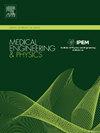Bone ingrowth in randomly distributed porous interbody cage during lumbar spinal fusion
IF 1.7
4区 医学
Q3 ENGINEERING, BIOMEDICAL
引用次数: 0
Abstract
Porous interbody cages are often used in spinal fusion surgery since they allow bone ingrowth which facilitates long-term stability. However, the extent of bone ingrowth in and around porous interbody cages has scarcely been investigated. Moreover, tissue differentiation might not be similar around the superior and inferior cage-bone interfaces. Using mechanobiology-based numerical framework and physiologic loading conditions, the study investigates the spatial distribution of evolutionary bone ingrowth within randomly distributed porous interbody cages, having varied porosities. Finite Element (FE) microscale models, corresponding to cage porosities of 60 %, 72 %, and 83 %, were developed for the superior and inferior interfacial regions of the cage, along with the macroscale model of the implanted lumbar spine. The implant-bone relative displacements of different porosity models were mapped from macroscale to microscale model. Bone formation of 10–40 % was predicted across the porous cage models, resulting in an average Young's modulus ranging between 765 MPa and 915 MPa. Maximum bone ingrowth of ∼34 % was observed for the 83 % porous cage, which was subject to low implant-bone relative displacements (maximum 50μm). New bone formation was found to be greater at the superior interface (∼34 %) as compared to the inferior interface (∼30 %) for P83 model. Relatively greater volume of fibrous tissue was formed at the implant-bone interface for the cage with 60 % and 72 % porosities, which might lead to cage migration and eventual failure of the implant. Hence, the interbody cage with 83 % porosity appears to be most favorable for bone ingrowth, provided sufficient mechanical strength is offered.

腰椎融合术中随机分布的多孔椎体间笼中的骨生长
多孔椎体间融合器通常用于脊柱融合手术,因为它允许骨质生长,有利于长期稳定性。然而,关于多孔椎间融合器内和周围的骨质生长程度还鲜有研究。此外,上、下椎体笼-骨界面周围的组织分化可能并不相似。本研究利用基于机械生物学的数值框架和生理加载条件,研究了随机分布的多孔椎间笼内不同孔隙率的进化骨生长的空间分布。研究人员针对椎体笼上、下界面区域以及植入腰椎的宏观模型建立了有限元(FE)微观模型,椎体笼孔隙率分别为 60%、72% 和 83%。从宏观尺度到微观尺度模型映射了不同孔隙率模型的植入物-骨相对位移。根据预测,多孔骨笼模型的骨形成率为 10-40%,平均杨氏模量介于 765 兆帕和 915 兆帕之间。在种植体与骨的相对位移较低(最大 50μm)的情况下,83% 多孔骨笼的最大骨生长量为 34%。与下界面(30%)相比,P83 模型的上界面(34%)有更多的新骨形成。孔隙率为 60% 和 72% 的椎体间骨架在植入物-骨界面形成的纤维组织量相对较大,这可能会导致椎体间骨架移位,最终导致植入物失效。因此,只要有足够的机械强度,孔隙率为 83% 的椎间笼似乎最有利于骨的生长。
本文章由计算机程序翻译,如有差异,请以英文原文为准。
求助全文
约1分钟内获得全文
求助全文
来源期刊

Medical Engineering & Physics
工程技术-工程:生物医学
CiteScore
4.30
自引率
4.50%
发文量
172
审稿时长
3.0 months
期刊介绍:
Medical Engineering & Physics provides a forum for the publication of the latest developments in biomedical engineering, and reflects the essential multidisciplinary nature of the subject. The journal publishes in-depth critical reviews, scientific papers and technical notes. Our focus encompasses the application of the basic principles of physics and engineering to the development of medical devices and technology, with the ultimate aim of producing improvements in the quality of health care.Topics covered include biomechanics, biomaterials, mechanobiology, rehabilitation engineering, biomedical signal processing and medical device development. Medical Engineering & Physics aims to keep both engineers and clinicians abreast of the latest applications of technology to health care.
 求助内容:
求助内容: 应助结果提醒方式:
应助结果提醒方式:


